Teka TK4 1270 User Manual [dk]
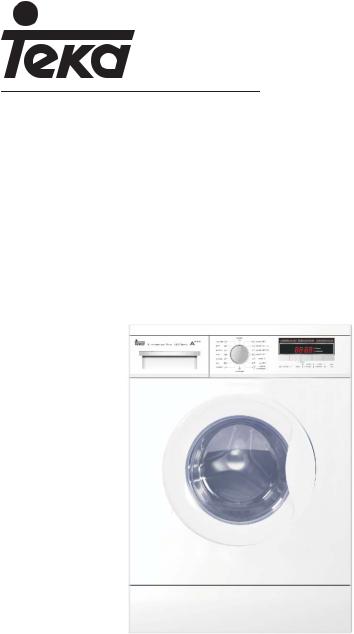
LAVADORA
INSTRUCTION MANUAL |
EN |
MANUAL DE INSTRUCCIONES |
ES |
MANUAL DE INSTRUÇÕES |
PT |
TK4 1270

Contents
Safety Precautions............................................................. |
3 |
Overview of Washing Machine.......................................... |
7 |
Install Washing Machine.................................................... |
8 |
Operate Washing Machine................................................. |
11 |
Checklist and Preparation before Washing Clothes..... |
12 |
View of Control Panel...................................................... |
15 |
Select the procedure....................................................... |
16 |
Table of Washing Procedures......................................... |
18 |
Maintenance....................................................................... |
19 |
Troubleshooting.................................................................. |
22 |
Appendix.............................................................................. |
24 |
Product Specifications....................................................... |
25 |
Product Fiche...................................................................... |
25 |

Safety Precautions
 Safety Precautions
Safety Precautions
-If the supply cord isdamaged,itmustbereplacedby the manufacturer,its service agent or similarly qua
-lified persons in order to avoid a hazard.
-Thenewhose-setssuppliedwiththeapplianceareto beusedandthatoldhose-setsshouldnotbereused.
-This washing machine is for indoor use only.
-The openings must not be obstructed by a carpet.
-(This warning is only for EUROPEAN market )This appliance can be used by children aged from 8 years and above and persons with reduced physical,sens
-ory or mentalcapabilitiesorlackofexperienceand knowledge if they have been given supervision or in
-struction concerning use of the appliance in a safe
-way and underst and the hazards involved. Children shall not play with theappliance.Cleaning anduser maintenance shall not be made by children without supervision.
-(This warning is not for EUROPEAN market)This ap
-pliance is not intended for use by persons (including children) with reduced physical, sensory or mental capabilities, or lack of experience and knowledge, unlesstheyhavebeengivensupervisionorinstruction concerning use of the appliance by a person respon
-sible fortheirsafety.Childrenshouldbesupervised to ensurethat they do not play with the appliance.
-Pulloutitsplugfromthepowersocketbeforecleaning or maintenance.

Safety Precautions
-Make sure that all pockets are emptied.
-Sharp and rigid items such as coin,brooch,nail,screw or stoneetc.maycauseseriousdamagestothismachine.
-Pulloutitsplugandcutoffwatersupplyaftertheoperation.
-Please checkwhetherthewaterinsidethedrumhasbeen drained before opening its door.Please do not open the door if there is any water visible.
-Pets and kids may climb into the machine. Check the machine before every operation.
-Glass door may be very hot during the operation.Keep kids and pets far away from the machine during the operation.
-Take care that power voltage and frequency shall be identical to those of washing machine.
-Donotuseanysocketwithratedcurrentlessthanthatof washingmachine.Neverpulloutpowerplugwithwethand.
-Toensureyoursafety,powercordplugmustbeinserted intoanearthedthree-polesocket.Checkcarefullyand makesurethatyoursocketisproperlyandreliablyearthed.
-Childrenoflessthan3yearsshouldbekeptawayunless continously supervised.
-Kids should be supervised to ensure that they do not play with the machine.
-Packing materials may be dangerous to the kids. Please keep all packing materials(plastic bags,foams etc) far away from the kids.
-Be careful of burning when washing machine drains hot washing water.

Safety Precautions
-Washing machine shall not be installed in bath room or very wet rooms as well as in the rooms with explos
-ive or caustic gases.
-Make sure that the water and electrical devices must be connected by a qualified technician in accordance with the manufacturer's instructions and local safety regulations.
-Before operating this machine,all packages and tran -sportboltsmustberemoved.Otherwise,thewashing machine may be seriously damaged while washing the clothes.
-Before washing the clothes at first time, the washing machine shall be operated in one round of the whole procedures without the clothes inside.
-The washing machine with single inlet valve only can be connected to the cold water supply.The washing machine with double inlet valves can be connected to the hot water and cold water supply.
-Your washing machine is only for home use and is only designed for the textiles suitable for machine washing.
-Flammable and explosive or toxic solvents are forbi
-dden.Gasolineandalcoholetc.Shallnotbeusedas detergents.Pleaseonlyselectthedetergentssuitable for machine washing, especially for drum.
-It is forbidden to wash carpets.
-Never refill the water by hand during washing.
-After the program is completed, Please wait for two minutes to open the door.
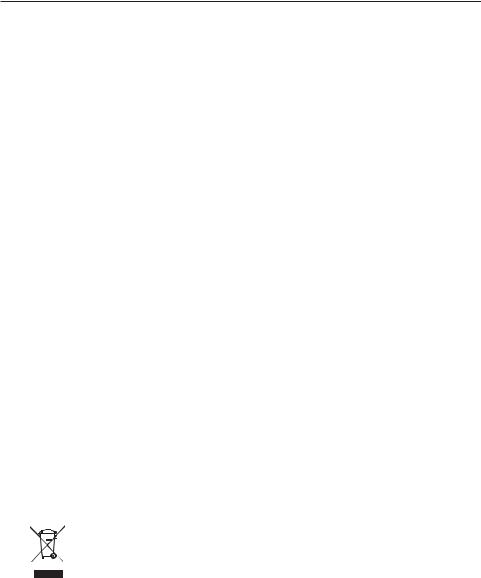
Safety Precautions
-Please remember to disconnect water and power supply immediately after the clothes are washed.
-Do not climb up and sit on top cover of the machine.
-Do not lean against machine door.
-Please do not close the door with excessive forces.If it is found difficult to close the door,pleasecheckifthe excessive clothes are put in or distributed well.
-The household washing machine isn't intended to be built-in.
-Cautions during Handling Machine
1.Transport bolts shall be reinstalled to the machine by a specialized person.
2.The accumulated water shall be drained out of the machine.
3. Handle the machine carefully. Never hold each prot
-rudedpartonthemachinewhilelifting.Machinedoor
cannotbeusedasthehandleduringtheconveyance. - Notes on disposal:
Thismarkingindicatesthatthisproductshouldnot be disposed with other household wastes throughout the EU. To prevent possible harm to the environment or human health from uncontrolled waste disposal,recycle it responsibly to promote the sustainable reuse of material resources.To return your used device,please use the collection systems or contact the retailer where the product was purchased.They return and can take this product for environmental safe recycling.
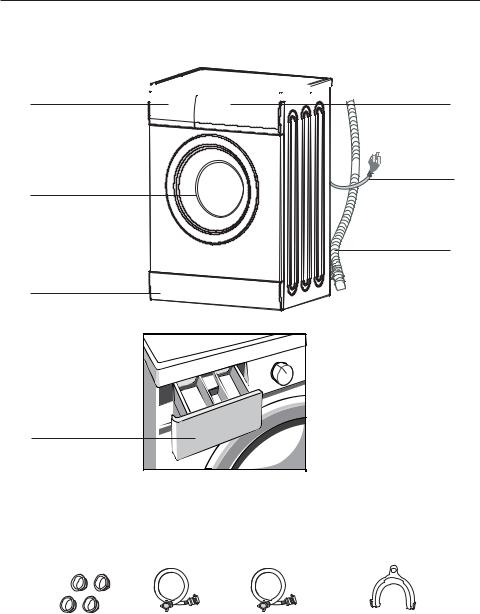
Overview of Washing Machine
 Component
Component
Detergent Drawer 



 Control Panel
Control Panel

 Power Plug
Power Plug
Door
Outlet Hose
Service Panel
Detergent Box
 Accessories
Accessories
Transport |
Inlet pipe |
Inlet pipe |
Outlet hose |
hole plug |
C |
H (optional) |
support(optional) |
|
|
|
|

Install Washing Machine
 Unpacking the washing machine
Unpacking the washing machine
Unpack your washing machine and check if there is any damage during the transportation. Also make sure that all the items (as shown in Page 5) in the attached bag are received. If there is any damage to the washing machine during the transportation, or any item is missing, please contact the local dealer immediately.
 Dispose the packing materials
Dispose the packing materials
The packing materials of this machine may be dangerous to kids. Please dispose them properly and avoid easy touch by kids. Please dispose the related packing materials according to the relevant local regulations. Please do no throw the packing materials away together with the other daily living rubbishes.
 Remove transport bolts
Remove transport bolts
Before using this washing machine, transport bolts must be removed from the backside of
this machine. Please take the following steps to
remove the bolts: 1.Loosen all bolts with spanner and then remove them. 2.Stop the holes with transport hole plugs.
3.Keep the transport bolts properly for future use.
 Select the location
Select the location
Before installing the washing machine, the location characterized as follows shall be selected:
-Rigid, dry, and level surface (if not level, please make it level with reference to the following figure “Adjust Leg”)
-Avoid direct sunlight
-Sufficient ventilation
-Room temperature is above 0 C
-Keep far away from the heat resources such as coal or gas.
Make sure that the washing machine will not stand on power cord. Do not install the washing machine on the carpet floor.
 Adjust Leg
Adjust Leg
1.When positioning the washing machine, please
first check if the legs are closely attached to the cabinet. If not, please turn them to their original positions with hand or spanner and tighten the nuts with spanner. 2.After positioning the washing machine, press
four corners on top cover of washing machine in sequence. If the washing machine is not stable when being pressed, this leg shall be adjusted.
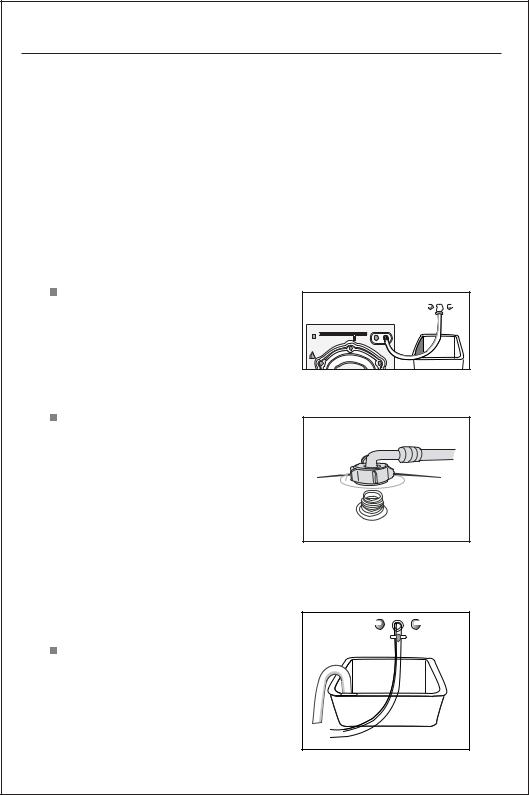
Install Washing Machine
3.Ensure the positioning status of washing machine. Loosen the lock nut with spanner and turn the leg with hand until it closely contacts with the floor. Press the leg with one hand and fasten the nut closely to the cabinet with the other hand.
4.After being locked properly, press four corners again to make sure that they has been adjusted properly. If it is still unstable, it has to repeat Steps 2 and 3.
5.Put a solid cylinder (e.g. pop cans) oppositely on the top cover of the washing machine from in the left, right, front and back directions. If the cylinder keeps stable, the washing machine is positioned level. If it rolls, the washing machine is positioned unlevel.The rolling direction is the
direction of lower ground surface.Then, the two legs in this direction shall be raised at the same time until the washing machine is level. Steps 1~3 are repeated to make the bottom legs closely against the ground and the nuts shall be locked tightly.
Connect inlet pipe
Connect the inlet pipe as indicated in the figure. For the model which has hot valve , please connect the hot vale to hot water tap. Energy will decrease automatically for some program.
Install inlet pipe
1.Connect the elbow to tap and fasten it clockwise.
2.Connect the other end of inlet pipe to the inlet valve at the backside of washing machine and fasten the pipe tightly clockwise.
Notes: after connection, if there is any leakage with hose, then repeat the steps to connect inlet pipe.The most common type of tap shall be used to supply water. If tap is square or too big, then standard tap shall be changed.
Place outlet hose
There are two ways to place the end of outlet hose: 1.Put it beside the water trough.
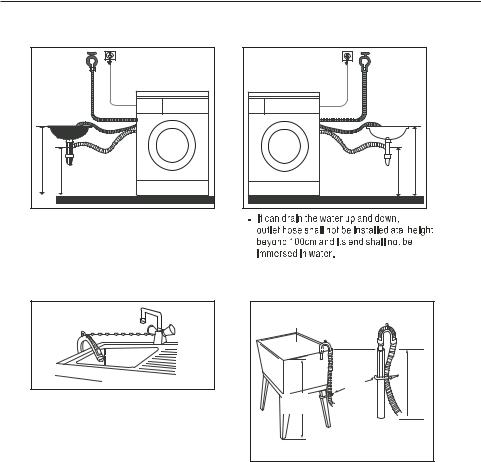
Install Washing Machine
2.Connect it to the branch drain pipe of the trough.
Max.100cm |
Min.60cm |
Min.60cm |
Max.100cm |
Position outlet hose properly so that the floor will not be damaged by water leakage.
Notes:
If the machine has outlet hose support, please install it like the following pictures.
-When installing outlet hose, fix it properly with a rope.
-Position outlet hose properly so that the floor will not be damaged by water leakage.
Trough |
|
|
|
Hose Retainer |
|
|
|
Bind |
Min.60cm |
Max.100cm |
|
Max.100cm |
|||
|
|
||
Min.60cm |
|
|
- If outlet hose is too long, do not force
it into washing machine as it will cause
abnormal noises.
 Electrical Connection
Electrical Connection
-As the maximum current through the unit is 10Awhen you are using its heating function, please make sure the power supply system (current, power voltage and wire) at your home can meet the normal loading requirements of the electrical appliances.
-Please connect the power to a socket which is correctly installed and properly earthed.
-Make sure the power voltage at your place is same to that in the machine's rating label.
-Power plug must match the socket and cabinet must be properly and effectively earthed.
-Do not use multi-purpose plug or socket as extension cord.
-Do not connect and pull out plug with wet hand.
-When connecting and pulling out the plug, hold the plug tightly and then pull it out. Do not pull power cord forcibly.
-If power cord is damaged or has any sign of being broken, special power cord must be selected or purchased from its manufacturer or service center for replacement.
10
10
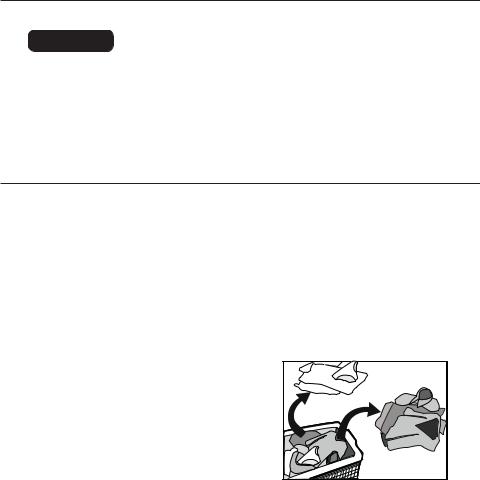
Install Washing Machine
 WARNING
WARNING
1.This machine must be earthed properly. If there is any short circuit, earthing can reduce the danger of electrical shock.
This machine is equipped with power cord, which includes plug, earthing wire at earthing terminal.
2.Washing machine shall be operated in a circuit separate from other electrical appliances. Otherwise, power protector may be tripped or fuse may be burned out.
Operate Washing Machine
 Checklist and Preparation before Washing Clothes
Checklist and Preparation before Washing Clothes
Please read this operation method carefully to avoid the troubles of washing machine and damages of clothes.
Check if the first-washed clothes will bed decolorized.
After a white towel touched with liquid detergent is used to wash the invisible corners of the clothes, check if the white towel is stained with
clothes' original color.
As for the scarves and those clothes that easily
get decolorized among imported clothes, please wash them separately before washing.
As for the stains on sleeves, collars and pockets, use the liquid detergent and wash it with brush
gently. Finally put them into the washing machine
to achieve more ideal washing effects. As for temperature-sensitive clothes, they shall be washed as required in the labels. Otherwise,
it may cause color change or distortion.
Keep in Mind:
Never put the clothes to be washed in washing machine for a long period of time. Otherwise it may get moldy and cause spots.Therefore, please wash the clothes in time. The clothes also may get color changed or distorted if they are not washed according to the stated washing temperature.
Clothes that can not be washed by washing machine
The clothes that may get distorted if being immersed in water:
Ties, waistcoats, western-style clothes, outer garments etc. may have obvious shrinkage if being immersed in water; the decolorized clothes such as blended spinning clothes of artificial fiber etc.
11
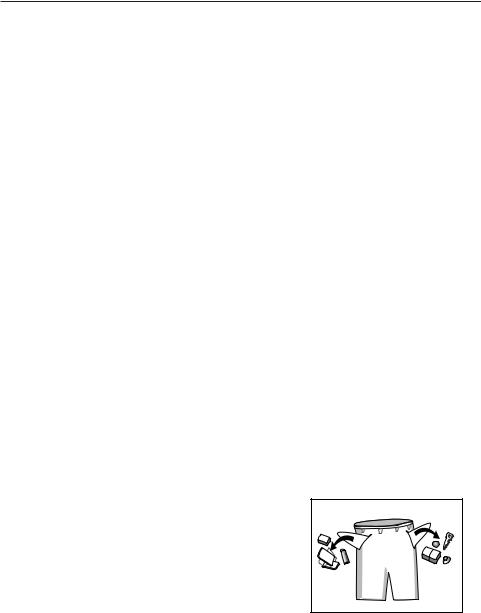
Operate Washing Machine
Wrinkle-style clothes, embossed clothes, resin clothes etc. may get distorted when being immersed in water.Among cotton and wool materials, the clothes that get easily distorted are wrinkle-style silk, fur products and fur decorations;
Clothes with decoration, long dress and traditional clothes etc are the products to get decolorized easily.
Please do not wash the clothes without material labels and washing requirements. Never wash the clothes stained with the chemicals such as gasoline, petroleum, benzene, paint thinner and alcohol.
Please pay attention with regard to detergents
“Low bubble” detergent or washing powder or washing powder special for drum washing machine shall be selected according to fiber types (cotton, synthetic fiber, soft products and wool products), colors, washing temperatures, dirty degrees and types. Otherwise, excessive bubbles may be generated and overflowed out of the drawer so that accidents may take place.
Bleacher belongs to alkali type and can damage clothes, so it is suggested to use as little as possible.
Powder detergents can easily leave the residues in the clothes so as to generate the bad smell, so they shall be sufficiently rinsed.
Detergent can not easily get dissolved completely if there is too much detergent or water temperature is rather low. It can remain in clothes, pipes and washing machines to pollute the clothes.
Washing shall follow the weight of clothes, dirty degrees, local water hardness as well as the recommendations from the detergent manufacturers. Please consult the water company if you are not clear of water hardness.
Notes:
Keep detergents and additives in safe and dry places out of touch by kids.
 Checklist and Preparation before Washing Clothes
Checklist and Preparation before Washing Clothes
Please take out the items out of the pockets.
Please check the pockets of the clothes to be washed, empty the rigid items such as decorations and coins, otherwise washing machine may be damaged or have abnormal troubles.
For the clothes to be washed, they are classified according to the following characteristics:
The symbol types of care labels: the clothes to be
washed are classified into cotton, blended fiber, synthetic fiber, silk, wool and artificial fiber.
12
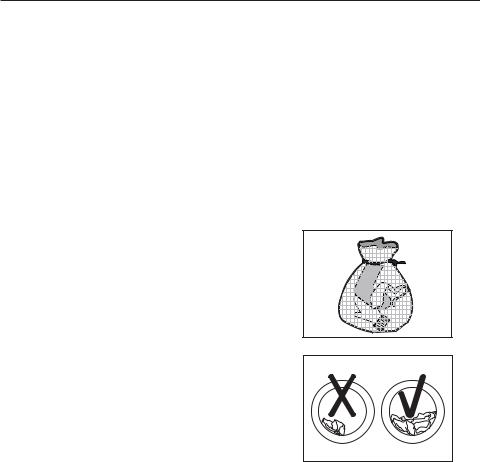
Operate Washing Machine
Color: white and colorful colors shall be identified.All new colorful articles shall be washed in a separate way.
Size: the articles of different sizes are washed together to increase the washing effects. Sensitivity: soft articles shall be washed separately.As for new pure wool textiles, curtains and silks, the soft washing procedure shall be selected. Check the labels in all washing articles.
The clothes shall be sorted before being put into washing machine.As for the curtains with hooks, the hooks shall be removed before being washed.
The decorations on the clothes may damage the washing machine.As for the clothes with buttons or embroideries, they shall be turned over before being washed.
Clean up fasteners:
Zips shall be zipped close and buttons or hooks shall be fixed.The loose band or ribbon shall be bound together.
 It is suggested to put bras into the pillow slip with zip or buttons sealed to prevent the steel wire from popping out of bras into the drum and damaging the machine. Especially delicate textiles such as laced curtains, straight jackets, small articles (tight socks, handkerchiefs, ties etc.) shall be put into string
It is suggested to put bras into the pillow slip with zip or buttons sealed to prevent the steel wire from popping out of bras into the drum and damaging the machine. Especially delicate textiles such as laced curtains, straight jackets, small articles (tight socks, handkerchiefs, ties etc.) shall be put into string
bag for washing.
When washing a single big and heavy dress such asTurkish towels, jeans, wadded jackets etc., it may easily cause great eccentricity and give
alarm due to great unbalance.Therefore it is suggested to add one or two more clothes to be
washed together so that draining can be done smoothly.
Clean away dusts, stains and pet hairs from the clothes.
The clothes may be damaged and disturb washing effects during the friction between dusts, stains and clothes.
To protect baby skin
Baby articles (baby clothes and towels) including napkins shall be washed separately. If they are washed together with the adults' clothes, they may be infected. Rinsing times shall be increased to ensure the thorough rinsing and cleaning without the detergent residues.
It is suggested that the parts that are easily stained such as white sockets, collars and sleeves etc. shall be hand washed before being put into washing machine to achieve more ideal washing effects.
Please use powder or liquid detergents.The residues of the soap could remain in the gaps of the clothes if soap is used.
13
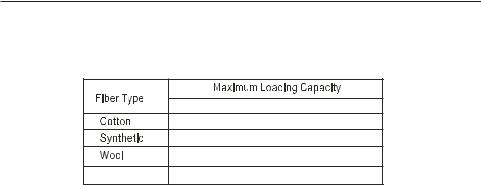
Operate Washing Machine
Confirm the washing capacity:
Do not put excessive washings; otherwise it may affect the washing effects. Please confirm the maximum affordable washing quantity according to the following table.
|
7.0kg |
|
7.0kg |
|
3.5kg |
|
2.0kg |
Delicate |
2.5kg |
The clothes which easily get fuzzed shall be turned over for washing
The clothes which easily get fuzzed shall be washed separately; otherwise the other articles can be stained with dust and thrum etc. Preferably, black clothes and cotton clothes shall be washed separately because they can easily get stained with the thrums of other colors when being washed together.
Please check before washing.
Washing machine shall not wash water-proof materials (ski suits, outside napkin pads, curtains).
As for the fiber products that water can not get soaked easily into such as water-proof cushions, and clothes, it is better not to wash. Otherwise there will be water bursting out or abnormal vibration to cause danger while rinsing and draining so that the clothes also may be damaged. (Such as outside napkin pads, raincoats, umbrella, ski suits, car covers, sleeping sacks etc.)
Cautions during Draining
Draining of normal clothes:
Moistures of washings are drained through drain hole.
Draining of water-proof clothes and fiber products:
In the normal washing and draining status, moistures of water-proof clothes and fiber products can not be drained while washing water is gathered in one direction so that the eccentricity of washing machine is too great and vibration or moving is caused.
14
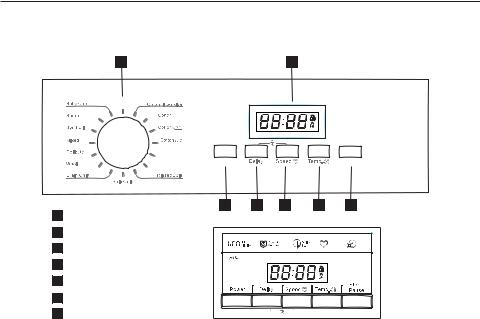
Operate Washing Machine
 View of Control Panel
View of Control Panel
1 |
2 |
My Cycle
Less consumption.
More efficiency.
6



 Press 3 sec. for Signal / My Cycle
Press 3 sec. for Signal / My Cycle
Quick 15'
|
Eco Wash |
On/Off |
|
|
Start/Pause |
|
1 |
PROGRAMME KNOB |
3 |
4 |
5 |
6 |
7 |
|
|
|
|
|
||
2 |
LED SCREEN DISPLAY |
|
|
|
|
|
3 |
ON/OFF BUTTON |
|
|
|
My Cycle |
Quick |
|
|
|
|
Wash |
||
|
|
|
|
|
||
4 |
DELAYBUTTON |
|
Press 3 sec. for Signal / My Cycle |
|
|
|
|
|
|
|
|
||
5 |
SPEED BUTTON |
|
|
|
|
|
6 |
TEMPERATURE BUTTON |
|
|
|
|
|
7 |
START/PAUSE BUTTON |
|
|
|
|
|
 Rotary Switch Function
Rotary Switch Function
There are 16 types of washing selection functions in display. For example:
Cotton intensive: With the corresponding temperature selections: 20, 30, 40, 60, 90 ,Cold
Cotton 60 ; Cotton 40 |
; Cotton 20 ; |
||
Quick15': 20, 30 , 40 |
, Cold |
||
Eco Wash : 20,30,40 |
,Cold |
||
Rinse&Spin:Cold |
|
|
|
Spin only:Cold |
|
|
|
Drain only |
|
|
|
Wool: 20 , 30,40 |
,Cold |
|
|
Delicate: 20,30 |
,Cold |
|
|
Mixed: 20, 30,40 |
,Cold |
|
|
Synthetic: 20, 30, 40, 60 |
,Cold |
||
Sports: 20, 30,40 |
,Cold |
|
|
Baby care:20, 30,40,60,90 |
,Cold |
||
My cycle |
|
|
|
Notes:
1.The Control panel line chart is for reference only,Please refer to real product as standard.
2.The Control panel could be changed without written notice. Please visit the website of Washing Machine or call up the service line for consultation.
15
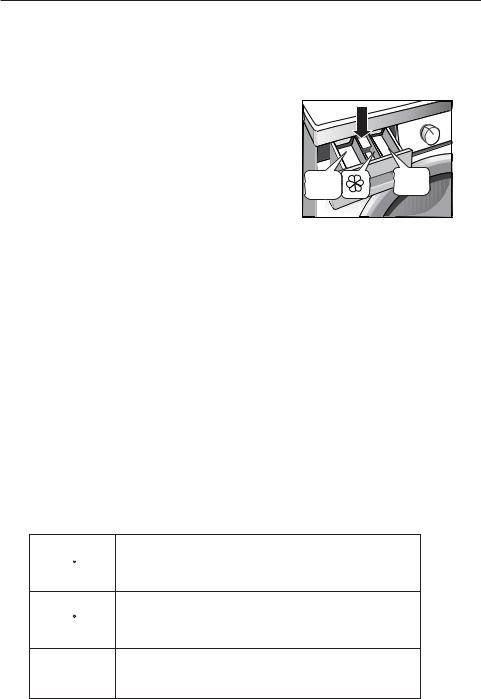
Operate Washing Machine
 Washing Clothes at first time
Washing Clothes at first time
Before washing clothes at first time, the washing machine shall be operated in one round of the whole procedures without clothes in as follows:
1.Connect power source and water.
2.Put a little detergent into the box and close it. 3.Press the button “On/Off”. 4.Press the button “Start/Pause”. The drawer is separated as follows:
I: Pre-detergent or washing powder.
II: main detergent, softener, pre-dip, bleaching or decontaminating products.
 : washing additive, such as fabric softener or tackifier.
: washing additive, such as fabric softener or tackifier.
 Put detergent into washing machine.
Put detergent into washing machine.
1.Pull out the drawer.
2.Fill pre-detergent into Case I (when necessary). 3.Fill detergent into Case II.
4.Fill softener into Case (when necessary).
(when necessary).
Notes:
-As for the agglomerated or ropy detergent or additive, before they are poured into the detergent box, it is suggested to use some water for dilution to prevent the inlet of detergent box from being blocked and overflowing while filling water.
-Please choose suitable type of detergent for the various washing temperature to get the best washing effect with less water and energy consumption.
 Start up washing machine
Start up washing machine
Connect the power. Check if water pipes are connected properly. Open the tap completely. Put in the clothes to be washed and fill in the detergent and tackifier.Then press the button “On/Off”,Select the proper procedures and functions and press the button “Start/Pause”.
 Select the procedure
Select the procedure
The proper washing procedures shall be selected according to the types, quantities, and dirtiness of the clothes to be washed in combination with the following washing temperature table.
|
Seriously besmirched, pure white cotton or flax (for example: coffee |
90 C |
table cloths, canteen table cloths, towels, bed sheets) |
Moderately besmirched, colorful flax, cotton and synthetic articles 60 C with certain decolorizing degree (for example: shirts, night pajamas;
Slightly besmirched, pure white flax (for example: underwear)
40 , 30 ,20 |
Normally besmirched articles (for example: synthetic and wool) |
Cold water |
|
16

Operate Washing Machine
First, turn the rotary switch to select the corresponding procedures according to the types of textiles.
Second, select the proper temperature according to the dirtiness. Generally, the higher the temperature is, the more the power is consumed.
Last, select the proper revolution speed.The higher the revolution speed is, the drier the textiles are spun, but higher the noises will also be increased.
The surfaces of delicate textiles will have wrinkles and the working life of washing machine will be shortened.
PLEASE NOTE: to protect the clothes, the lower revolution speed shall be selected for delicate textiles.The main washing procedures depend on the types of the clothes to be washed.The main washing troubles can be selected as follows:
- Cotton Intensive
To increase the washing effects, main additional washing time is increased.
It is recommended to wash the clothes for babies or worn by the persons with allergic skin. - Cotton
You can select this procedure to wash the daily washable clothes.The washing period is quite long with quite strong washing intensions. It is recommended to wash the daily cotton articles, for example: bed sheets, quilt covers, pillowcases, gowns, underwear etc.
- Quick 15
This procedure is suitable for washing few and not very dirty clothes quickly. - Eco Wash
As for few light dirty clothes, the maximum temperature of washing is limited to 40 , and saving more energy.
- Baby care
Baby care procedure with an extra rinse, it can make the baby's wear cleaner and make the rinse performance better to protect the baby skin.
- Sports
You can select this procedure to wash the activewear. - Synthetic
You can select this procedure to wash the quite delicate clothes.The procedure is shorter compared with that for cottons and the washing intension is quite gentle. It is recommended to wash synthetic articles, for example: shirts, coats, blending.As for curtains and laced textiles, the procedure “Synthetic ” shall be selected. While washing the knitting textiles, detergent quantity shall be reduced due to its loose string construction and easily forming bubbles.
- Mixed
You can select this procedure wash the tough cltohes, that need much more time and strength .It is used for the daily clothes fo cotton,such as sheets, chained, pillowcases bathrobe and underwear.
- Delicate
You can select this procedure to wash your delicate clothes. Its washing intension is gentler and revolution speed is less compared with the procedure “Synthetic”. It is recommended for the articles to be washed softly.
- Wool
You can select this procedure to wash the wool textiles labeled with “Machine Wash”. Please select the proper washing temperature according to the label on the articles to be washed. Furthermore, the proper detergent shall be selected for wool textiles.
17
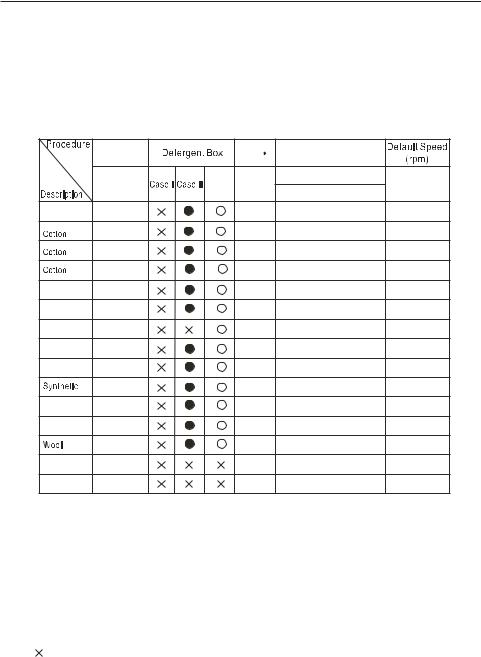
Operate Washing Machine
- Bubble Removal Function
Bubble Check Function: Redundant bubbles will occur when there is excessive detergent, which will affect Wash and Rinse effects.The procedure will check automatically and one bubble removal procedure will be added automatically to remove bubbles when excessive bubbles are checked.
 Table of Washing Procedures
Table of Washing Procedures
|
Load(kg) |
|
Default |
DefaultTime |
|
|
|
Temp.(C) |
(Min) |
|
|
|
7.0 |
Softener |
7.0 |
7.0 |
1200 |
|
1200 |
||||
|
|
Case |
|
|
|
Cotton Intensive |
7.0 |
|
40 |
1:58 |
1000 |
60 |
7.0 |
|
60 |
3:46 |
1200 |
40 |
7.0 |
|
40 |
3:42 |
1200 |
20 |
7.0 |
|
20 |
1:13 |
1000 |
Quick 15' |
2.0 |
|
Cold |
0:15 |
800 |
Eco Wash |
2.0 |
|
30 |
1:06 |
800 |
Rinse&Spin |
7.0 |
|
- |
0:31 |
1000 |
Baby Care |
7.0 |
|
60 |
1:39 |
1000 |
Sports |
3.5 |
|
40 |
1:19 |
800 |
|
3.5 |
|
40 |
1:33 |
1200 |
Mixed |
7.0 |
|
40 |
1:13 |
1000 |
Delicate |
2.5 |
|
30 |
1:00 |
600 |
|
2.0 |
|
40 |
1:06 |
400 |
Drain Only |
- |
|
- |
0:01 |
0 |
Spin Only |
7.0 |
|
- |
0:12 |
1000 |
The energy class isA+++
Energy test program: Cotton 60 /40 , Speed: the highest speed; Other as the default.
Half load for 7.0Kg machine: .5Kg.
"Cotton 60 /40 " are the "standard cotton 60 /40 " programme and the standard washing programs to which the information in the label and the fiche relates,and they are suitable to clean normally soiled cotton laundry and that they are the most efficient programmes in terms of combined energy and water consumptions for washing that type of cottonlaundry,thattheactualwatertemperaturemaydifferfromthedeclaredcycletemperature.
Means must
Means optional
Means not necessary
Notes: The parameters in this table are only for user's reference.The actual parameters maybe different with the parameters in above mentioned table.
18
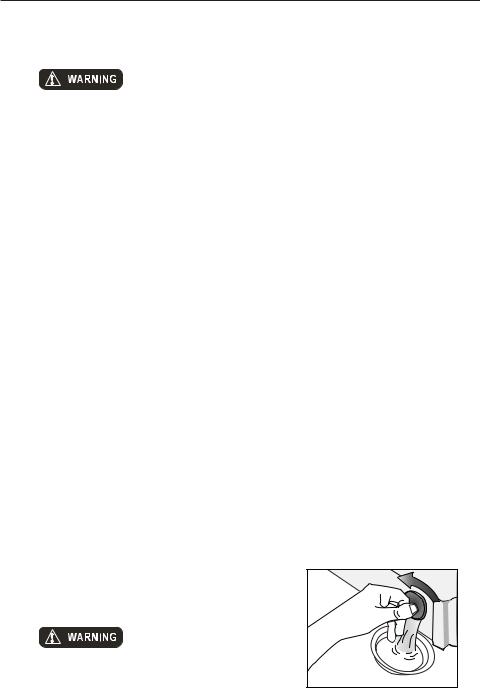
Maintenance
Before your maintenance starts, please do pull out the power plug or disconnect power and close the tap.
-Solvents are forbidden to avoid that the washing machine is damaged, and toxic gases are generated or exploded.
-Never use water to sprinkle and wash the washing machine.
-It is forbidden that the detergents containing PCMX are used to clean the washing machine.
 Cleaning and Maintenance of Washing Machine Cabinet
Cleaning and Maintenance of Washing Machine Cabinet
Proper maintenance on the washing machine can extend its working life.The surface can be cleaned with diluted non-abrasive neutral detergents when necessary. If there is any water overflow, use the wet cloth to wipe it off immediately. No sharp items are allowed to strike the cabinet.
Notes: formic acid and its diluted solvents or equivalent are forbidden.
 Clean Internal Drum
Clean Internal Drum
The rusts left inside the drum by the metal articles shall be removed immediately with chlorine-free detergents.
Never use steel wool.
 Dispose a Frozen Washing Machine
Dispose a Frozen Washing Machine
When the temperature drops below zero and your washing machine gets frozen, you may: 1.Disconnect the power supply for the washing machine.
2.Wash the tap with warm water to loosen inlet pipe. 3.Take down inlet pipe and immerse it in warm water.
4.Pour warm water into washing drum and wait for 10 minutes.
5.Reconnect inlet pipe to the tap and check whether inlet and outlet are working normally.
Notes: when the washing machine is reused, make sure the ambient temperature is above 0 C
C
 Anti-freeze
Anti-freeze
If your washing machine is located in the room where it can get frozen easily, please drain the remaining water inside drain pipe and inlet pipe thoroughly.
Remove the remaining water in inlet pipe: 1.Close the tap.
2.Screw off the inlet pipe from tap and put its end into the container. 3.Start up any procedure except single Wash or Drain
procedure. Water will be drained out of inlet pipe if any
for about 40 seconds. 4.Reconnect the inlet pipe to tap.
Remove the remaining water in drain pump
To avoid burning, it shall be done after the hot water inside the machine cools down.
19
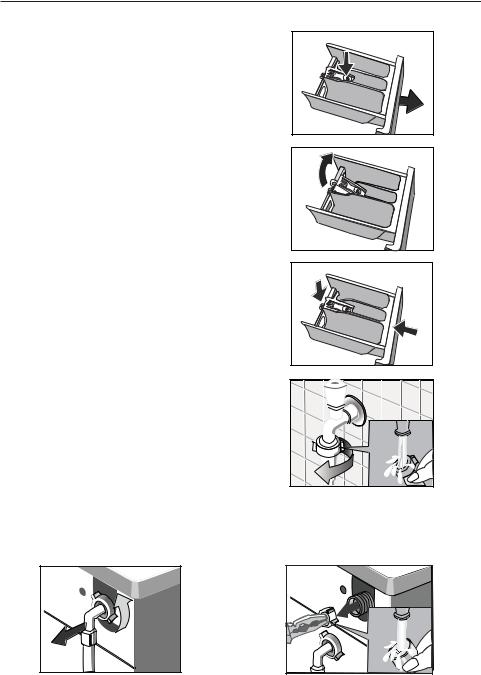
Maintenance
 Clean detergent box and grooves
Clean detergent box and grooves
Clean detergent drawer and grooves
1.Press down the arrow location on softener cover inside the drawer. 2.Lift the clip up and take out softener cover and wash
all grooves with water.
3.Restore the softener cover and push the drawer into position.
 Clean inlet filter
Clean inlet filter
Inlet filter shall must be cleaned if there is not any or insufficient water in when the tap is opened. Clean the tap filter:
1.Close the tap.
2.Select any procedure except “Wash” or “Drain” procedure.
3.Press the button “Start/Pause” and keep the
procedure running for about 40 seconds. 4.Remove the inlet pipe from the tap. 5.Use water to wash the filter. 6.Reconnect the inlet pipe.
Washing the filter in washing machine: 1.Screw off the inlet pipe from the backside of the
machine. 2.Pull out the filter with long nose pliers and reinstall
it back after being washed. 3.Reconnect the inlet pipe.
4.Open the tap and make sure there is no water leakage. 5.Close the tap.
Notes: Generally, the tap filter is washed first and then the filter in washing machine will be washed. If only the filter in washing machine is washed, then the steps 1~3 in cleaning the tap filter shall be repeated.
20
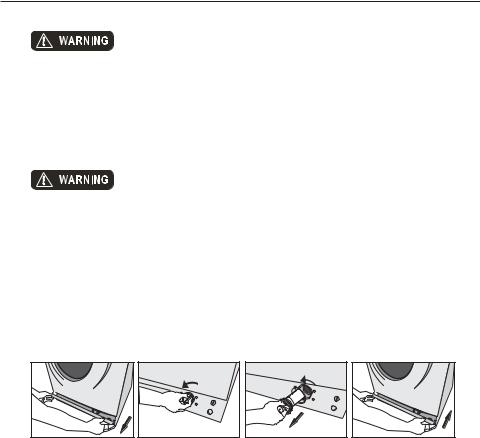
Maintenance
Pull out the power plug to avoid electrical shock before washing.
After using the washing machine, pull out the power cord and close the door tightly to avoid pinching the kids.
 Remove foreign matters Drain Pump Filter:
Remove foreign matters Drain Pump Filter:
Drain pump filter can filter the yarns and small foreign matters from the washings. Clean the filter periodically to ensure the normal operation of washing machine.
First, drain the water with drain pump and then open the drain pump to clean away foreign matters from drain pump filter.
Take care if the drained water is hot. Cleaning the pump
Important!
According to the soil level within the cycles and the frequency of the cycles,you have to inspect and clean the filter regularly.
The pump should be inspected if the machine does not empty and/or spin;
The machine makes an unusual noise during draining due to objects such as safety pins,coins etc. blocking the pump.
Proceed as follows:
Open the service panel Unscrew the pump cover Remove the pump cover Close the service panel
1 Disconnect the appliance;
2 If necessary wait until the water has cooled down.
3 Open the service panel .Place a container close to collect any spillage. 4 When no more water comes out, unscrew the pump cover and remove it.
Always keep a rag nearby to dry up spillage of water when removing the cover. 5 Remove any objects from the pump impeller by rotating it.
6 Screw the pump cover fully in.
7 Close the service panel.
Warning!
When the appliance is in use and depending on the programme selected there can be hot water in the pump. Never remove the pump cover during a wash cycle, always wait until the appliance has finished the cycle, and is empty. When replacing the cover,ensure it is securely retightend so as to stop leaks and young children being able to remove it.
21
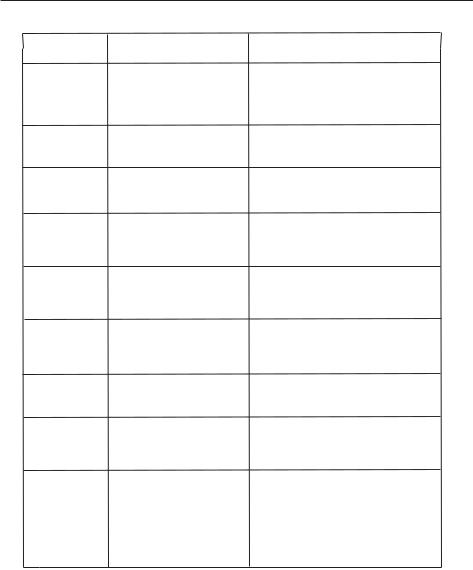
Troubleshooting
Troubles
Washing machine cannot start up
Door cannot be opened
Heating fault
Water leakage
Water is overflowed from the bottom of the machine
Indicator or display does not light.
Detergent residues in the box
Washing effects are not good
Abnormal noise
Great vibration
Reason Solution
Machine's safety protection design is working.
NTC is damaged and heating pipe is aging.
The connection between inlet pipe or outlet hose and tap or washing machine is not tight.
Drain pipe in the room is blocked.
The inlet pipe is not connected
firmly.
Outlet hose has water leakage.
Power is disconnected. PC board has problems. Harness has connection problem.
Washing powder is dampened and agglomerated.
The clothes are too dirty.
Insufficient detergent quantity.
Check if the door is closed tightly.
Check if power plug is inserted well.
Check if water supply tap is opened.
Check if button “Start/Pause” is pressed.
Check if button “On/Off” is pressed.
Disconnect the power.
Can normally wash the clothes.
Only cannot wash with heating.
Shall contact the service center promptly.
Check and fasten water pipes. Clean up outlet hose and ask a specialized person to repair it when necessary.
Fix the inlet pipe.
Replace the drain hose.
Check if the power is shut down and power plug is connected correctly. If not, please call up service line.
Clean and wipe the box.
Use liquid detergents or the detergents special for drum.
Select a proper procedure.
Add the proper detergent quantity according to the instructions in detergent package.
Check if the fixing (bolts) has been removed. If cabinet is installed on the solid and level floor.
Check if there are any barrettes or metal articles inside.
Check if the legs in the washing machine are adjusted level.
22
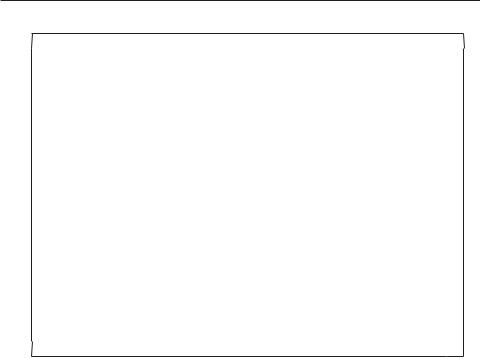
Remove the problems
Display |
Description |
Reason |
Solution |
|
LED |
||||
|
|
|
||
|
|
|
|
|
E30 |
Door lock |
Door is notclosed properly. |
Restartafterthe door isclosed |
|
problem |
Please call up service line if there are still troubles. |
|||
|
|
|||
|
|
|
|
|
|
|
Tap isnot opened or water |
Open the taporwait till |
|
|
|
the water supply |
||
|
|
flows too slowly. |
||
|
|
becomes normal. |
||
|
|
Inlet valve filter is blocked. |
||
|
Water injecting |
Check inletvalve filter. |
||
|
Inletpipe is twisted. |
|||
E10 |
Straightenthewater pipe |
|||
problemwhile |
If water isnot supplied |
|||
Check the othertapsin |
||||
|
washing |
|
theroom. |
|
|
|
|
||
|
|
Please call up service lineif there are still troubles. |
||
|
|
|
|
|
|
Drainproblem |
Outlet hose is blocked ortwisted |
Washand straighten outlet hose. |
|
E21 |
Drain pump is blocked |
Wash drainpumpfilter |
||
whilewashing |
||||
|
|
|
|
|
|
|
Pleasecall up service line if there are still troubles. |
||
|
|
|
|
|
|
Please call up the service line ifthere is any other problem. |
|||
23
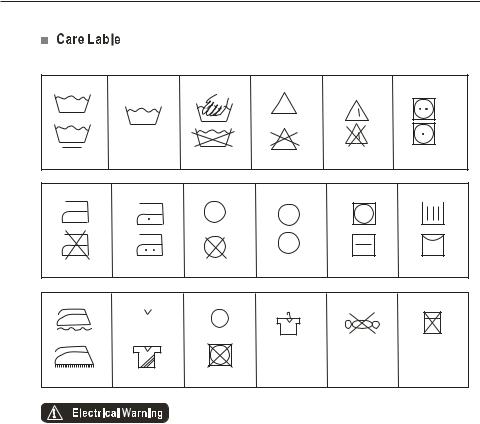
Appendix
The label and sign on the fabric can help you to choose the best way to launder your clothes.
Normal wash
40
Warm |
wash |
(max 40 |
) |
Gentle wash
Hand wash |
Bleach |
Chlorine bleach |
Tumble dry. Medium |
|
|
|
may be used |
(max 150 |
) |
|
|
C |
|
|
|
|
C |
|
|
Do not wash |
Do not bleach |
Chlorine bleach |
Tumble dry. Low heat |
|
not be used |
(max 110 |
) |
||
Iron |
Cool iron(max 110 ) |
Dry clean |
Drycleannormalcycle Tumbledrynormal |
Drip dry |
||
withanysolvent |
|
|
|
A
F
Do not iron |
Warm iron.medium |
(max 150 ) |
Do not dry clean |
Drycleannormalcycle |
petroleumsolventonly |
Dry flat |
Hang to dry |
|
/Line dry |
||
|
Iron with cloth |
Dry after wash |
Warmly dry clean |
||||||
|
|
|
|
|
|
|
|
|
|
|
|
|
|
|
|
|
|
Line Dry |
No Wring |
No machine wash |
Steam Iron |
Line Dry in shade Do not tumble dry |
To avoid fire,electrical shock and other accidents,please remember the following reminding:
-Only the voltage indicated in power label can be used. If you are not clear of the voltage at home, please contact the local power bureau.
-When you are using the heating function, the maximum current through the washing machine will reach 10A.Therefore, please make sure the power supply units (current, voltage and cable) can meet the normal load requirements for the machine.
-Protect the power cord properly. Power cord shall be fixed well so that it will not trip the people or other things and be damaged. Special attention shall be paid to the socket. It shall be plugged into the sockets easily and attention shall be paid to the plug location.
-Do not make the wall-mounted socket overloaded or cable extended. Overloading of the wiring may cause fire or electrical shock. Do not pull out power plug with wet hand.
-To ensure your safety, power plug shall be inserted into an earthed three-pole socket. Carefully check and ensure that your socket is properly and reliably earthed.
24
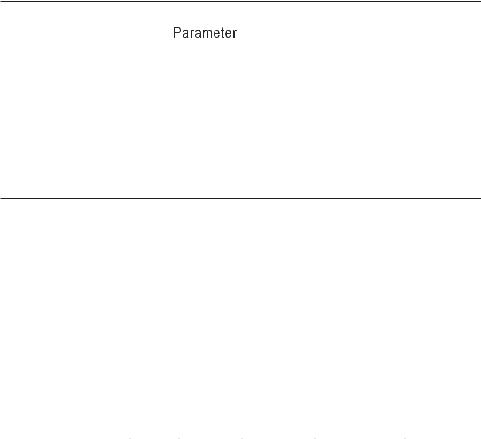
Product Specifications
|
|
Washing Capacity |
7.0kg |
|
|
Dimension(W*D*H) |
595*495*850 |
Weight |
61kg |
|
|
Rated Power |
2050W |
|
|
Power Supply |
220-240V~,50Hz |
Rated Current |
10A |
|
|
Standard Water Pressure |
0.05MPa~1MPa |
|
|
Product Fiche
Brand:TEKA
Model:TK4 1270
Rated capacity:7kg
Energy efficiency class:A+++
EU Ecolabel:N/A
Energy consumption 175kwh per year, based on 220 standard washing cycles for cotton at 60°C/40°C at full and partial load, and the consumption of the low-power modes. Actual energy consumption will depend on how the appliance is used.
Water consumption 10000 litres per year, based on 220 standard washing cycles for cotton at 60°C /40°C at full and partial load.Actual water consumption will depend on how the appliance is used.
Spin-drying efficiency class B on a scale from G (least efficient) to A (most efficient) Maximum spin speed:1200rpm
Consumption values(1200rpm):
Standard Programme |
Load |
Energy |
Water |
Remaining |
Programme |
consumption |
consumption |
moisture content |
duration |
||
Cotton 60°C |
7kg |
0.92kwh |
50L |
50% |
226min |
Cotton 60°C |
3.5kg |
0.68kwh |
42L |
55% |
212min |
Cotton 40°C |
3.5kg |
0.64kwh |
42L |
55% |
206min |
Notes:
1.Programme setting for testing in accordance with applicable standard EN60456-2011.
2.When using the test programmes, wash the specified load using the maximum spin speed.
3.The actual parameters will depend on how the applicance is used,and maybe different with the parameters in above mentioned table.
Off mode power consumption:0.5W
Left-on mode power consumption:1W
Airborne acoustical noise (washing):58
Airborne acoustical noise (spinning):76
Notes:The airborne acoustical noise emissions during washing/spinning for the standard
60 cotton programme at full load.
25
Índice
1. Instrucciones de seguridad............................................................................ |
5 |
1.1. Energía de alimentación.......................................................................... |
6 |
1.2. Cable de alimentación y otros cables .................................................... |
6 |
1.3. Humedad y agua ..................................................................................... |
6 |
1.4. Limpieza .................................................................................................. |
6 |
1.5. Precauciones generales.......................................................................... |
7 |
2. Utilización y funcionamiento........................................................................ |
10 |
2.1. Descripción del producto ....................................................................... |
10 |
2.2. Panel de control .................................................................................... |
10 |
2.3. Funciones de los botones...................................................................... |
11 |
2.4. Instalación.............................................................................................. |
12 |
2.4.1. Desembalar su lavadora ................................................................ |
12 |
2.4.2. Eliminar los materiales del embalaje............................................... |
12 |
2.4.3. Quitar los tornillos de transporte .................................................... |
12 |
2.4.4. Seleccionar una localización.......................................................... |
12 |
2.4.5. Ajustar los pies................................................................................ |
13 |
2.4.6. Conexión del tubo de entrada........................................................ |
14 |
2.4.7. Instalación del tubo de entrada...................................................... |
14 |
2.4.8. Colocar la manguera de salida ....................................................... |
14 |
2.4.9. Conexión eléctrica .......................................................................... |
16 |
|
3 |
|
2.5. Funcionamiento de la lavadora...................................................................... |
17 |
|
2.5.1. Lista de verificación y preparación antes de lavar ropa................. |
17 |
|
2.5.2. Lavar ropa por primera vez........................................................... |
19 |
|
2.5.3. Ropa que no puede lavarse en la lavadora ................................... |
20 |
|
2.5.4. Verificación de las primeras ropas lavadas .................................. |
20 |
|
2.5.5. Detergentes para su lavadora........................................................ |
21 |
|
2.5.6. Colocar detergente en su lavadora................................................ |
22 |
|
2.5.7. Iniciar su lavadora .......................................................................... |
22 |
|
2.5.8. Selección de programas.................................................................. |
22 |
|
2.5.9. Selección de funciones especiales ................................................ |
25 |
|
2.5.10. Tabla de programas de lavado .................................................... |
27 |
|
2.5.11. Método de lavado......................................................................... |
28 |
|
2.6. Etiquetas de cuidados........................................................................... |
30 |
3. |
Mantenimiento............................................................................................ |
..31 |
4. |
Solución de problemas .............................................................................. |
..36 |
5. |
Especificaciones técnicas ......................................................................... |
..39 |
6. |
Ficha del producto ..................................................................................... |
..39 |
7. |
Postventa ................................................................................................... |
..41 |
8. |
Conservación del medio-ambiente............................................................... |
42 |
4
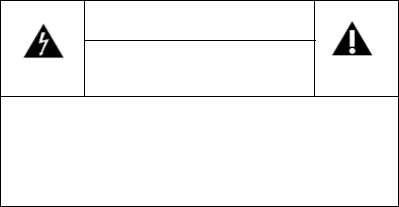
1. Instrucciones de Seguridad
ATENCIÓN
Riesgo de electrocución No Abrir
Atención: para reducir el riesgo de electrocución, no abra esta unidad. No contiene elementos que deba reemplazar el usuario. solicite la asistencia de personal especializado.
Avisos Importantes
Antes de usar su aparato lea atentamente este manual de instrucciones y guárdelo en un lugar seguro, puede volver a necesitarlo en el futuro.
Antes de poner el aparato en funcionamiento y de forma a garantizar su correcta utilización, no lo utilice si:
Ha caído al suelo;
Nota alguna señal de daño;
Surge alguna anomalía durante su funcionamiento;
Para evitar peligro y deterioro de su aparato debido a su uso incorrecto, se aconseja que se lea atenta y cuidadosamente las instrucciones.
Este aparato no deberá ser utilizado para otros fines que no sean los previstos en el manual de instrucciones. Su seguridad está prevista para el uso doméstico y no para su uso comercial. Su uso incorrecto anula automáticamente el derecho a la garantía.
Asistencia
Compruebe que, en caso de avería, entrega su aparato a personal especializado.
5

Este aparato puede ser utilizado por niños con 8 años o edad superior y por personas con capacidades físicas, Sensoriales o mentales reducidas, o personas con falta de experiencia o conocimiento si les ha sido dada supervisión o instrucciones en relación a la utilización de este aparato de un modo seguro y si entienden los riesgos que acarrean. Los niños no deben jugar con el aparato.La limpieza y mantenimiento no deben ser realizados por niños sin supervisión.
1.1. Energía de Alimentación
Compruebe que el voltaje de la red eléctrica es compatible con el que viene indicado en el aparato. En el caso de que no sean compatibles consulte a su vendedor o al Servicio de apoyo al cliente.
1.2. Cable de Alimentación y Otros Cables
Apague su aparato siempre que no lo esté utilizando.
No enrolle ni tire por el cable de alimentación para desenchufar el aparato, ni lo utilice par a envolver el aparato. mantenga el cable alejado de superficies calientes.
Nunca utilice este aparato si tiene el cable o toma dañados o si no está funcionando adecuadamente.
Si el cable de alimentación está dañado,no utilice su aparato, llévelo a un técnico autorizado para que proceda a su sustitución.
1.3. Humedad y Agua
No utilice su aparato en lugares húmedos. No deje que su aparato se moje de ninguna manera, puede ser peligroso. PARA EVITAR PELIGRO DE
INCENDIO O DESCARGA ELÉCTRICA, NO EXPONGA EL APARATO AL AGUA O HUMEDAD. No sumerja su aparato (por ejemplo para lavarlo).
1.4. Limpieza
Antes de efectuar la limpieza, apague siempre el aparato y retire el cable de la fuente de alimentación.
6
La superficie del aparto puede limpiarse con detergentes no abrasivos diluidos cuando sea necesario.
1.5.Precauciones Generales
Por favor siga las instrucciones del manual de instrucciones, que ayuda en la instalación y operación adecuada de este producto y en sus características avanzadas. Por favor guarde las instrucciones para futuras referencias.
Lea todas las instrucciones antes de usar el aparato.
Si el cable de alimentación está dañado, debe ser sustituido por el fabricante, su agente de servicio o por personal debidamente cualificado para evitar peligros.
Debe usar los nuevos conjuntos de mangueras suministrados con el aparato y los conjuntos antiguos no deben reutilizarse.
Esta lavadora fue concebida solamente para utilizaciones en habitaciones interiores y no al aire libre.
Las aberturas no deben estar obstruidas por una alfombra o moqueta.
Retire siempre el cable de alimentación de la toma eléctrica antes de efectuar cualquier operación de limpieza o mantenimiento.
Certifíquese de que todos los bolsillos de sus ropas están vacíos.
Objetos puntiagudos y rígidos como monedas, broches, uñas, tornillos, piedras, etc., podrán provocar daños graves en su lavadora.
Retire el cable de alimentación y cierre el suministro de agua tras la
operación del aparato.
Por favor verifique si el agua en el interior del tambor fue drenada antes de abrir la puerta. Por favor no abra la puerta si es visible agua en su interior.
Las mascotas y los niños podrán subirse a la lavadora. Verifique la lavadora antes de cada operación.
La puerta de vidrio puede estar muycaliente durante el funcionamiento del aparato. Mantenga los niños y las mascotas alejados de la lavadora durante la operación.
Certifíquese de que el voltaje de alimentación y la frecuencia son idénticos a los de su lavadora.
7
